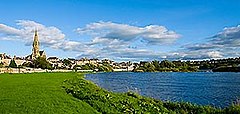Kelso, Scotland
Kelso
|
|
|---|---|
 Kelso seen from the Cobby Tweedside meadow |
|
| Kelso shown within the Scottish Borders | |
| Population | 5,639 (2011) |
| OS grid reference | NT7268233961 |
| • Edinburgh | 44 mi (71 km) |
| • London | 350 mi (560 km) |
| Council area | |
| Lieutenancy area | |
| Country | Scotland |
| Sovereign state | United Kingdom |
| Post town | KELSO |
| Postcode district | TD5 |
| Dialling code | 01573 |
| Police | Scottish |
| Fire | Scottish |
| Ambulance | Scottish |
| EU Parliament | Scotland |
| UK Parliament | |
| Scottish Parliament | |
Kelso (Scots: Kelsae Scottish Gaelic: Cealsaidh,) is a market town in the Scottish Borders area of Scotland. Within the boundaries of the historic county of Roxburghshire, it lies where the rivers Tweed and Teviot have their confluence. The town has a population of 5,639 according to the 2011 census and based on the 2010 definition of the locality.
Kelso's main tourist draws are the ruined Kelso Abbey and Floors Castle, a William Adam designed house completed in 1726. The Kelso Bridge was designed by John Rennie who later built London Bridge.
The town of Kelso came into being as a direct result of the creation of Kelso Abbey in 1128. The town's name stems from the fact that the earliest settlement stood on a chalky outcrop, and the town was known as Calkou (or perhaps Calchfynydd) in those early days, something that is remembered in the modern street name, "Chalkheugh Terrace".
Standing on the opposite bank of the River Tweed from the now-vanished royal burgh of Roxburgh, Kelso and its sister hamlet of Wester Kelso were linked to the burgh by a ferry at Wester Kelso. A small hamlet existed before the completion of the abbey in 1128 but the settlement started to flourish with the arrival of the monks. Many were skilled craftsmen, and they helped the local population as the village expanded. The abbey controlled much of life in Kelso-area burgh of barony, called Holydean, until the Reformation in the 16th century. After that, the power and wealth of the abbey declined. The Kerr family of Cessford took over the barony and many of the abbey's properties around the town. By the 17th century, they virtually owned Kelso.
...
Wikipedia

